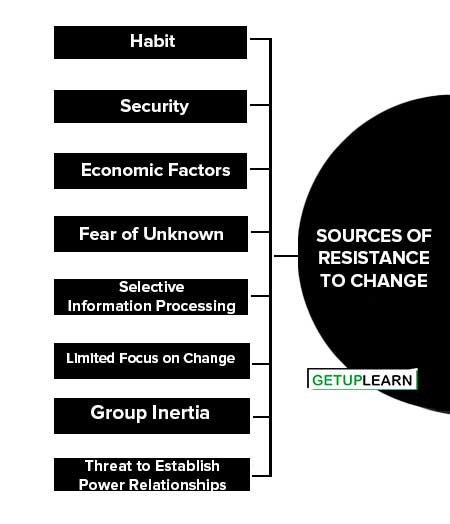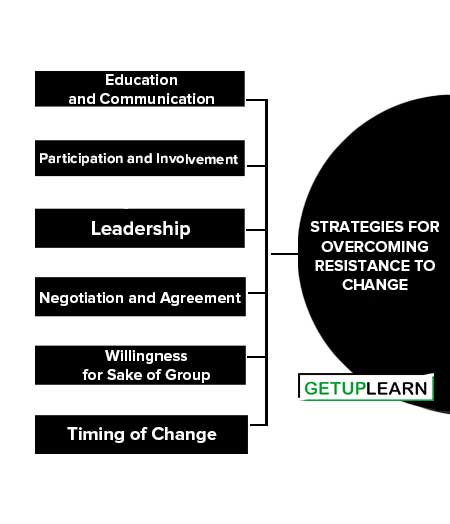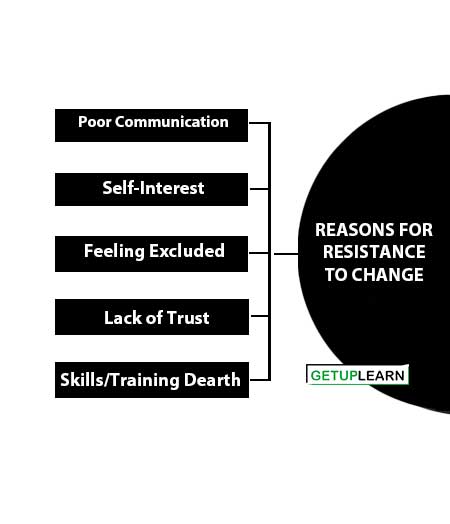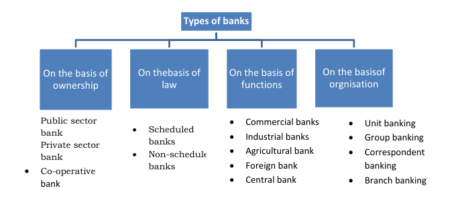Table of Contents
What is Resistance to Change in Organizations?
In the management of change effectively, the managers face the problem of resistance to change. People tend to resist many types of changes because new habits or sacrifices are required. Resistance to change involves employee behavior designed to discredit, delay or prevent the changes introduced for the development of an organization.
They resist because they are afraid of their job security, working conditions, status, and other factors. The perceived threat may be real or imaginary. They complain about the effectiveness of changes that may harm them more than benefit the organization.
Sources of Resistance to Change
These are the two major sources of resistance to change individual resistance and organizational resistance. We have categorized them in further detail:
- Habit
- Security
- Economic Factors
- Fear of Unknown
- Selective Information Processing
- Limited Focus on Change
- Group Inertia
- Threat to Establish Power Relationships
- Threat to Establish Resource Allocations

Individual Resistance
Individual sources of resistance to change reside in basic human characteristics such as perceptions, personalities, and needs. The following summarizes five reasons why individuals may resist change:
Habit
Human beings are creatures of habit. Life is complex enough; we don’t need to consider the full range of options for the hundreds of decisions we have to make every day.
To do so, we develop habit which is nothing but programmed responses. So whenever we are confronted with changes, this tendency to respond in our accustomed ways becomes a source of resistance. For example:- day shift working.
Security
People with a high need for security are likely to resist change because it threatens their feelings of safety.
Economic Factors
Another source of individual resistance is concern that changes will lower one’s income. Changes in job tasks or established work routines also can arouse economic fears if people are concerned that they won’t be able to perform the new tasks, so they stuck to routines of their previous standards, especially when pay is closely tied to productivity.
Fear of Unknown
Changes substitute ambiguity and uncertainty for the unknown. The transition from high school to college is typically such an experience.
Selective Information Processing
Individuals shape their world through their perceptions. Once they have created this world, it resists change. So individuals are guilty of selectively processing information in order to keep their perceptions intact. We hear what we want to hear. We ignore information that challenges the world we’ve created.
Organizational Resistance
- Limited Focus on Change
- Group Inertia
- Threat to Establish Power Relationships
- Threat to Establish Resource Allocations
Limited Focus on Change
Organizations are made up of a number of mutually dependent subsystems. So, you can’t change one without affecting the others.
For example, if management changes the technological processes without simultaneously modifying the organization’s structure to match, the change in technology is not likely to be accepted. So limited changes in subsystems tend to get nullified by the larger systems.
Group Inertia
Even if individuals want to change their behavior, group norms may act as a constraint. An individual union member, for instance, may be willing to accept changes in his job suggested by management. But if union norms dictate resisting any unilateral change made by management, he’s likely to resist.
Threat to Establish Power Relationships
Any redeployment of decision-making authority can threaten long-established power dealings within the organization. The introduction of participative decision-making or self-managed work teams is the kind of change that is often seen as threatening by supervisors and middle managers.
Threat to Establish Resource Allocations
Those groups in the organizations that control sizable resources often see change as a danger. They tend to be content with the way things are. Those who most benefit from the allocation current allocations of resources often feel threatened by changes that may affect future allocations.
Strategies for Overcoming Resistance to Change
If the changes are to be implemented successfully, they need full acceptance from employees. The easiest way to get this acceptance is the participation of employees in the change effort. Some of the specific strategies for overcoming resistance to change are explained below:
- Education and Communication
- Participation and Involvement
- Leadership
- Negotiation and Agreement
- Willingness for Sake of Group
- Timing of Change

Education and Communication
If the employees do not have adequate information or if the information that they have is inaccurate, then it is necessary to educate them about the change, its process, and its working.
Participation and Involvement
The process of change should be genuinely wanted by the employees so that they are more enthusiastic about it. Participation of employees would ensure commitment to the implementation of change. Secondly, participation will be easier to obtain from the individuals if they see some personal benefit to be gained from the change.
Leadership
The greater the prestige and credibility of the manager, who is acting as a change agent, the greater his influence upon the employees who will be involved in the change process.
Negotiation and Agreement
The negotiation and agreement technique is used when costs and benefits must be balanced for the welfare of all concerned parties. This is often used in bargaining with labor unions.
It is especially important in situations where the individuals or groups will end up as losers as a result of the change and where such individuals and groups have considerable power to resist.
Willingness for Sake of Group
Some individuals may be willing to accept changes, even if they are not totally satisfied with it if the group that they belong to is willing to accept the change. This is especially true about the individuals who have a continuous psychological relationship with the group so that there is group “cohesiveness or group together”.
Timing of Change
Timing of the introduction of change can have a considerable impact on the resistance. There is always a right time and a wrong time to introduce something new. The right time, obviously will meet less resistance. Therefore, management must be very careful in choosing the time when the organizational climate is highly favorable to change.
Reasons for Resistance to Change
Resistance to change happens, and it threatens the success of the venture. Resistance affects the speed at which an innovation is adopted. It affects the feelings and opinions of employees at all stages of the adoption process. It affects productivity, quality, and relationships.
It is difficult for organizations to avoid change, as new ideas promote growth for them and their members. Change occurs for many reasons such as new staff roles; increases or decreases in funding; acquisition of new technology; new missions, vision, or goals; and to reach new members or clients. These are the following reasons for resistance to change:

Poor Communication
Changes within an organization start with key decision-makers. It is up to them to pass along the details to team members and ensure all questions and complaints are handled before changes go into effect.
Unfortunately, as news of a change spreads through the hierarchy, details are sometimes skewed and members end up receiving inaccurate, second-hand information. Poor communication can therefore cause resistance to change.
Self-Interest
Ego often interferes with the ability to adapt to change. Some want to maintain the status quo to better advance their own personal agendas; others have different motivations. In the end, employees acting in their own self-interest, instead of the organization’s greater good, will resist change.
Feeling Excluded
Organizations often solicit advanced input to ensure that everyone has an opportunity to voice their ideas and opinions. If, however, employees hear of a sudden change, and they had no input, they will feel excluded from the decision-making process and perhaps offended.
Lack of Trust
Trust plays a big role in running a successful organization. When organization members feel they cannot trust each other or key decision-makers, it becomes difficult for them to accept organizational changes. They may ascribe the changes to some negative underlying reason or even assume they will eventually lose their jobs.
Skills/Training Dearth
When change requires mastering new skills, resistance is likely, particularly when it comes to new technology. Organizations can prevent this by offering education and training.
FAQs About the Resistance to Change
What are the sources of resistance to change?
The sources of resistance to change are: Habit, Security, Economic Factors, Fear of the Unknown, Selective Information Processing, Limited Focus on Change, Group Inertia, Threat to Establish Power Relationships, and Threat to Establish Resource Allocations.
What are the strategies for overcoming resistance to change?
The following are the strategies for overcoming resistance to change:
1. Education and Communication
2. Participation and Involvement
3. Leadership
4. Negotiation and Agreement
5. Willingness for the Sake of Group
6. Timing of Change.
What are the reasons for resistance to change?
Some important reasons for resistance to change:
1. Poor Communication
2. Self-Interest
3. Feeling Excluded
4. Lack of Trust
5. Skills/Training Dearth.

